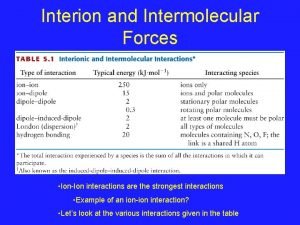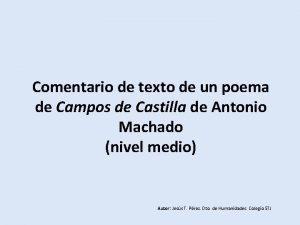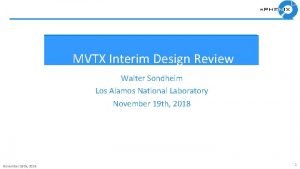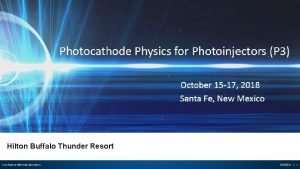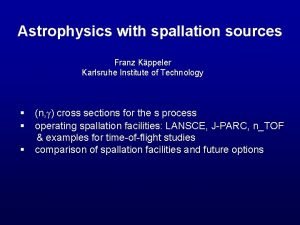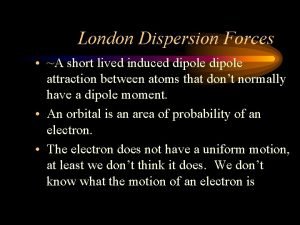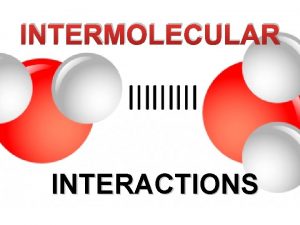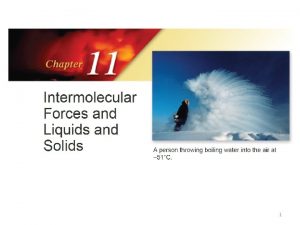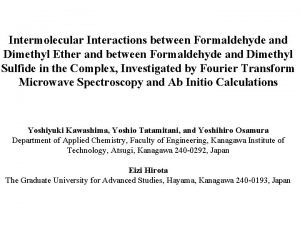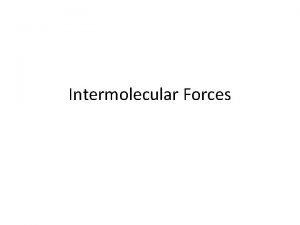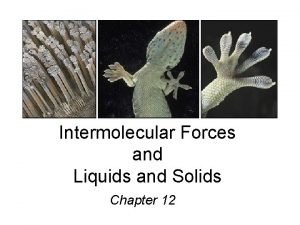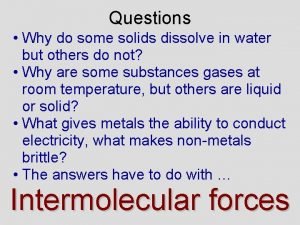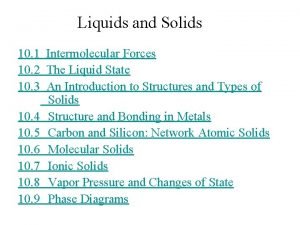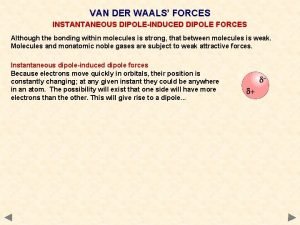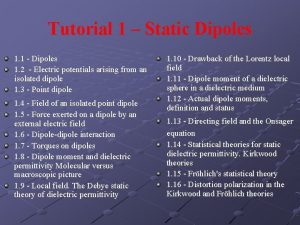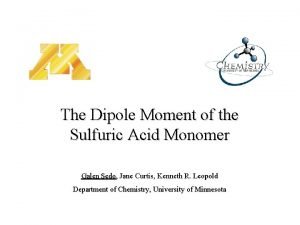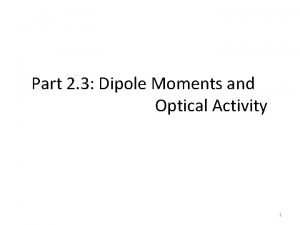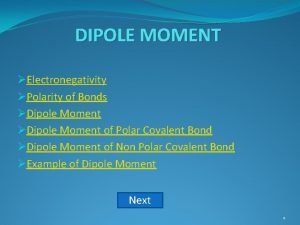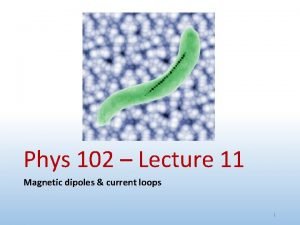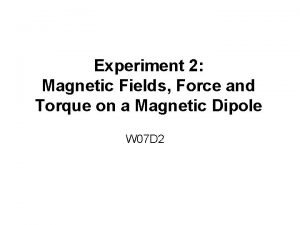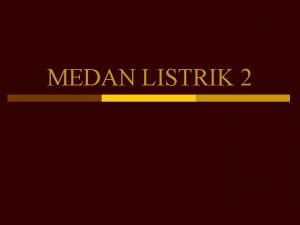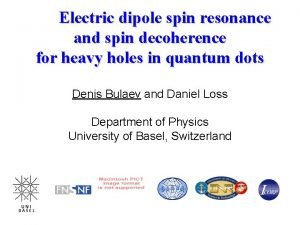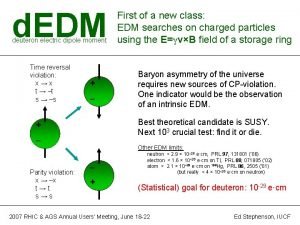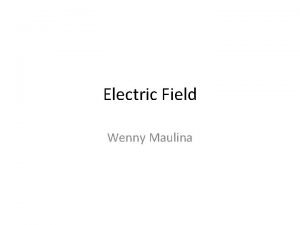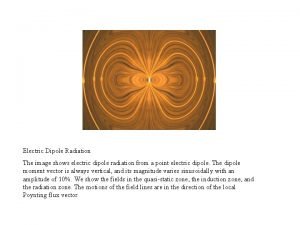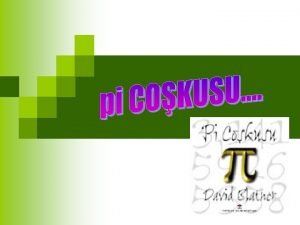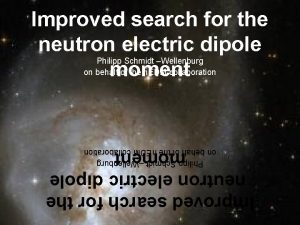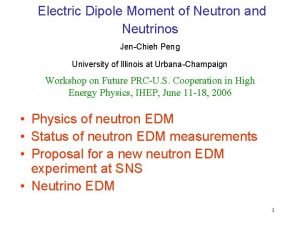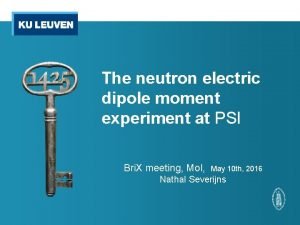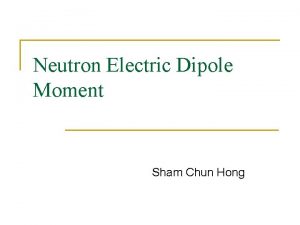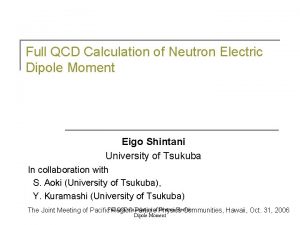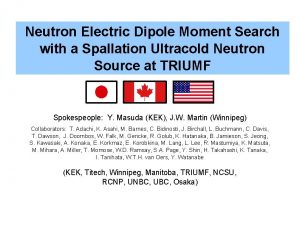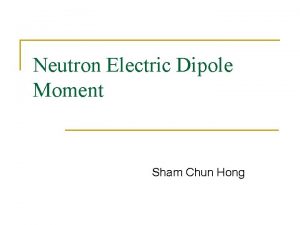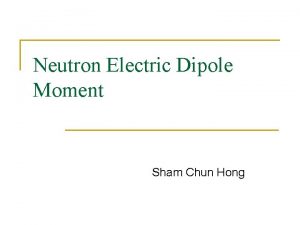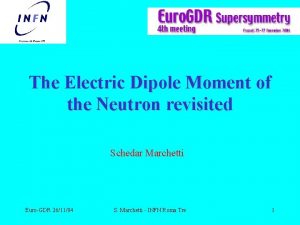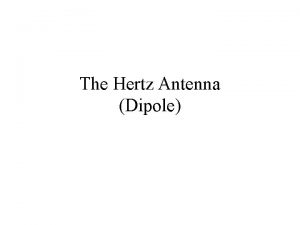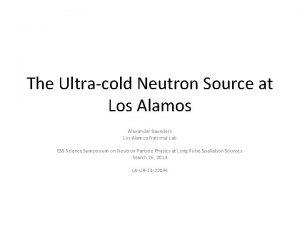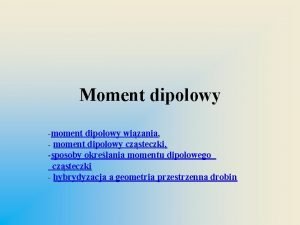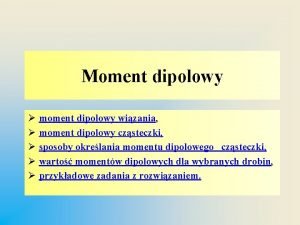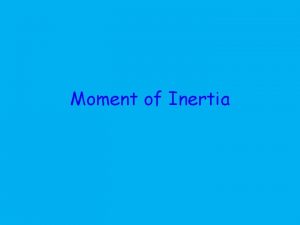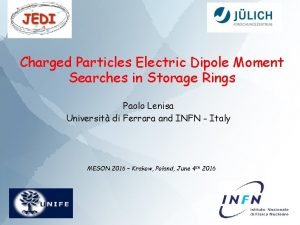Neutron Electric Dipole Moment Rajan Gupta Los Alamos



































- Slides: 35

Neutron Electric Dipole Moment Rajan Gupta Los Alamos National Lab d μ + - In collaboration with: • Tanmoy Bhattacharya • Vincenzo Cirigliano • Boram Yoon

Neutron EDM and CP Violation • Measures separation between centers of (+) and (-) charges d S S P + - • Current bound: |dn| < 2. 9× 10 -26 e cm + T d d + • Nonzero n. EDM violates P and T (CP if CPT holds) S

Neutron EDM Searches • Predictions – Standard Model |dn| 10 -31 e cm – Supersymmetry |dn| 10 -25 – 10 -28 e cm • Experiments targeting 5× 10 -28 e cm precision – – – PSI EDM Munich FRMII RCNP/TRIUMF SNS n. EDM JPARC

Impacts • New source of CP violation – CPV in SM is not sufficient to explain observed baryon asymmetry • Test of Supersymmetry and other BSM models – In many BSM theories, n. EDM is predicted to be in the range 10 -26 – 10 -28 e cm

Effective Lagrangian at 2 Ge. V dim=4 QCD θ-term dim=5 Quark EDM (q. EDM) dim=5 Quark Chromo EDM (CEDM) dim=6 Weinberg 3 g operator dim=6 Four-quark operators • • : Strong CP problem Effectively dim=5 suppressed as dq ≈ v/ΛBSM 2 ; Dim=6 terms Lattice QCD: calculate their ME within nucleon state

Spinor transformation under Parity P, CP-even P, CP-violating Dirac Eq. Parity Op. • CPV interactions phase in neutron mass term γ 4 no longer parity op of neutron state Ø Introduce new parity operator or Ø Rotate neutron state so that γ 4 remains the parity op: Abramczyk, et al. , PRD 96 (2017) 014501

F 3: The CP Violating Form Factor Expand the matrix element in terms of Lorentz covariant form factors The contribution of each CPV operator to n. EDM is given by

Two equally important challenges for lattice QCD • Signal in the CP violating form factor F 3 is small • Need very high statistics • Renormalization and divergent mixing between operators • Needs non-perturbative calculation of mixing coefficients in order to obtain results that are finite in the continuum limit

QCD θ-term

QCD θ-term • Calculate d. N in presence of CP violating θ-term • Lattice calculation strategies – Expansion in θ – External electric field method – Simulations with imaginary θ

Expansion in θ •

Form Factors with Parity Mixing Abramczyk, et al. , PRD 96 (2017) 014501 • Otherwise Phase mixes F 2 and F 3 • Corrections calculated with assumptions & approximations • Corrected lattice data consistent with zero • May resolve tension between phenomenology and lattice results

External Electric Field Method • In the presence of uniform electric field , a change of energy for the nucleon state due to the θ-term is • Neutron correlator with θ-term via reweighting • Electric field applied only to valence quarks • Does not need form-factor analysis nor extrapolation to q 2=0

Simulation with Imaginary θ • Avoid imaginary action (sign problem) by • Analytic continuation for small |θ| • dn is extracted from F 3 Guo, et al, PRL 115 (2015) 062001 Stout Link Nonperturbative Clover, a = 0. 074 fm

Quark EDM Leading contribution comes from the change in the vector current Generates an additional piece in the vector current

Quark EDM • n. EDM from q. EDMs given by the tensor charges g. T • dq mq in many models; mu/md≈1/2, ms/md≈20 Precise determination of g. Ts is important

Quark EDM • Tensor charges: Nf=2+1+1 Clover-on-HISQ (a=0, mπ=135 Me. V) • -0. 211(16) 0. 811(31) -0. 0023(23) • Constraints on dq using |dn| < 2. 9× 10 -26 e cm Bhattacharya, et al. , PRL 115 (2015) 212002

Quark Chromo EDM (c. EDM)

Quark Chromo EDM • Calculate d. N in presence of CP violating c. EDM term • Three methods explored – Expansion in – External electric field method – Schwinger source method

Expansion in • Calculate the four-point correlation function • • dn obtained from the form-factor F 3

Expansion in Connected Diagrams Propagators Needed • Four-point correlator is evaluated using Regular and backward props (F, B), c. EDM sequential prop (C) and doubly-sequential props (E, G) Abramczyk, et al. , PRD 96 (2017) 014501

Expansion in c. EDMU = 3. 7(1. 1) c. EDMD = 13. 1(1. 5) Abramczyk, et al. , PRD 96 (2017) 014501 • DWF • a = 0. 11 fm • mπ=340 Me. V

External Electric Field Method • In the presence of uniform electric field • Neutron correlator with CEDM term via reweighting • • DWF a = 0. 11 fm mπ=340 Me. V E 0 = 0. 039 Ge. V 2 Abramczyk, et al. , PRD 96 (2017) 014501 c. EDMU = 4. 6(2. 8) c. EDMD = 12. 5(4. 2)

Schwinger Source Method •

Reweight by the ratio of determinants + Connected disconnected 25

Schwinger Source Method • Calculation performed at small ε so that results are linear in ε • c. EDM mixes with γ 5, so need calculation with both operators • Calculate contribution of each to F 3 Tests at a = 0. 09 fm, Mπ=310 Me. V

Renormalization • Renormalization of c. EDM Operators are studied – 1 -loop perturbation on twisted-mass fermion [Constantinou, et al, 2015] – 1 -loop and Nonperturbative [Bhattacharya, et al, 2015] • Mixing with dimension-3 operator: 1/a 2 mixing

Quark Chromoelectric Operator: Mixing Bhattacharya et al, PRD 92 (2015) 114026 ( ar. Xiv: 1502. 07325 [hep-ph]) 28

Ongoing work • Weinberg Three-gluon Operator • Renormalization and mixing – Gradient Flow

Summary • QCD θ-term Actively being calculated; need better precision • Quark EDM (Done) Calculated: g. Td =0. 811(31); g. Tu =-0. 211(16); g. Ts =-0. 0023(23) • Quark Chromo EDM Exploratory studies started; need to address disconnected diagrams & renormalization/mixing • Weinberg Three-gluon Operator Exploratory studies just started • Four-quark Operators Not yet explored Should have better estimate of accuracy achievable in 1 -2 years

Split Supersymmetry • All scalars but one Higgs doublet are much heavier than ΛEW Has gauge coupling unification, dark matter candidate Avoids flavor and CP constraints mediated by 1 -loop terms with scalars Fermion EDMs arise at 2 -loops: phases in gaugino-Higgsino sector communicated to SM fermions through γh, Zh, WW exchanges chromo. EDM, Weinberg, …, operators do not arise at 2 -loop ed the work of Giudice & Romanino, PL B 634 (2006) 307 • • 31

Constraint on Split Supersymmetry • • The correlation between dn and de provides a constraint on Split SUSY. Using our estimates of g. T(u, d, s) and de=8. 7 ✕ 10 -29 e cm gives a stringent upper bound: dn < 4 x 10 -28 e cm Contours of dn , de versus gaugino (M 2) Correlation between dn , de in split SUSY. Bands and Higgsino (μ) mass parameters are for different dn/de (ϕ independent) and solid setting tanβ=1 and sinϕ=1 lines are for de=8. 7 ✕ 10 -29 e cm & sinϕ=0. 2 and 1. 32 Bhattacharya et al, PRL 115 (2015) 212002

4 -pt functions: Quark Chromo EDM 33

Schwinger Source Method c. EDM P Reweighting Connected Diagrams Disconnected diagrams

Schwinger Source Method • Quark chromo EDM operator is bilinear in quark fields • Modify the Dirac operator to include the c. EDM term. Invert this matrix to generate valence quark propagators Effectively • 3 -point correlators; d. N extracted from F 3 • Change in Fermion determinant = reweighting factor
 Ion-dipole interaction example
Ion-dipole interaction example Electric dipole moment
Electric dipole moment Campos de castilla comentario
Campos de castilla comentario Sondheim
Sondheim Los alamos resorts
Los alamos resorts Lansce los alamos
Lansce los alamos Dispersion forces vs dipole dipole
Dispersion forces vs dipole dipole Ion induced dipole example
Ion induced dipole example Dispersion forces vs dipole dipole
Dispersion forces vs dipole dipole Capillary action
Capillary action Intermolecular forces of formaldehyde
Intermolecular forces of formaldehyde Imfs
Imfs Dipole dipole bond
Dipole dipole bond Induced dipole
Induced dipole Dipole-dipole attractions
Dipole-dipole attractions Intramolecular forces
Intramolecular forces Phase diagram of carbon dioxide
Phase diagram of carbon dioxide Zumdahl chemistry
Zumdahl chemistry Instantaneous dipole induced dipole
Instantaneous dipole induced dipole Polarizability dipole moment
Polarizability dipole moment H2so4 dipole moment
H2so4 dipole moment Dipole moment of thulium nucleus
Dipole moment of thulium nucleus Magnetic dipole moment
Magnetic dipole moment Symmetry molecules
Symmetry molecules Dipole moment polarity
Dipole moment polarity Magnetic moment
Magnetic moment Force on magnetic dipole
Force on magnetic dipole Holt physics chapter 16 test
Holt physics chapter 16 test Dipol listrik adalah
Dipol listrik adalah Electric dipole spin resonance
Electric dipole spin resonance Deuteron
Deuteron Potential energy in uniform electric field
Potential energy in uniform electric field Electric field of dipole
Electric field of dipole Electric dipole image
Electric dipole image Rajan dermatology
Rajan dermatology Rajan mahadevan
Rajan mahadevan
